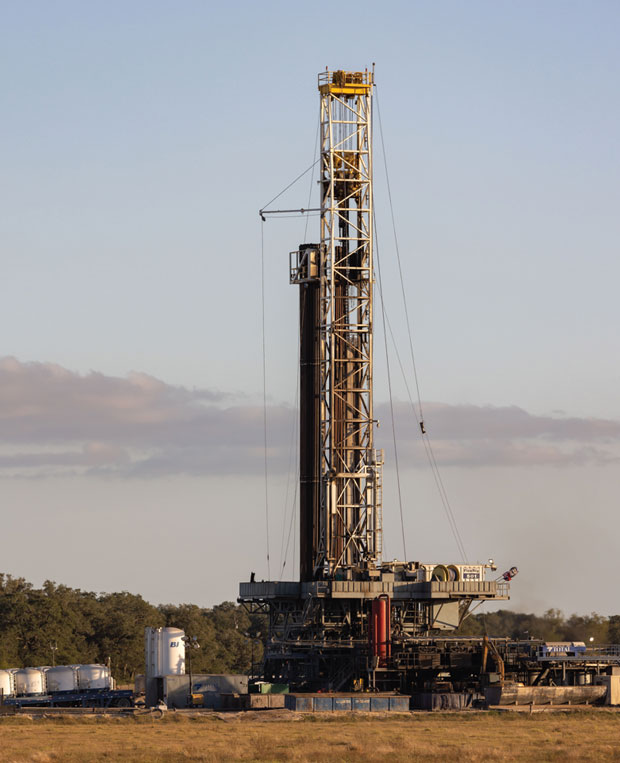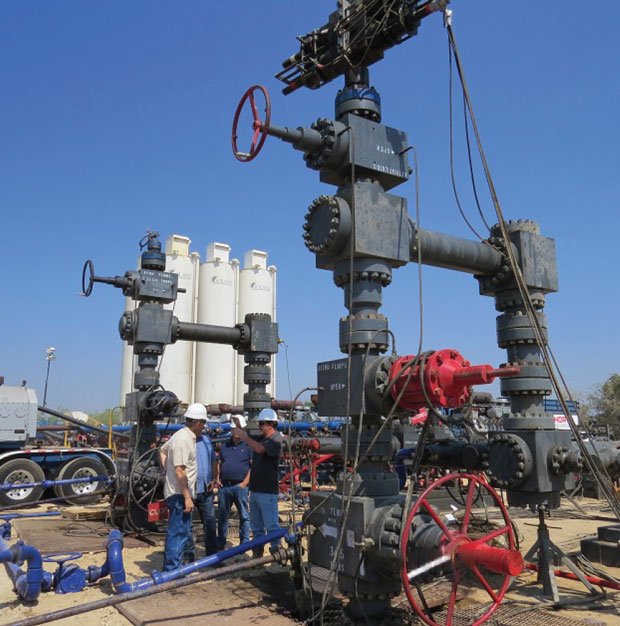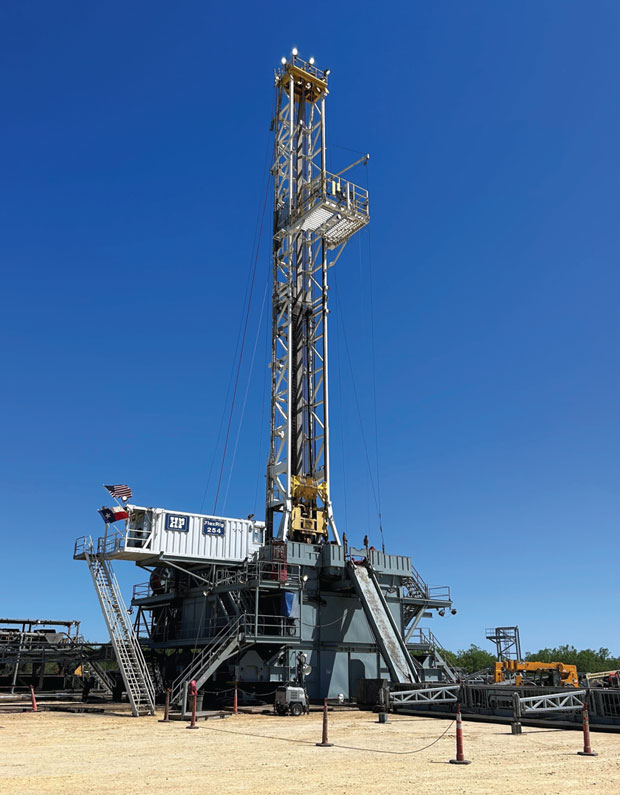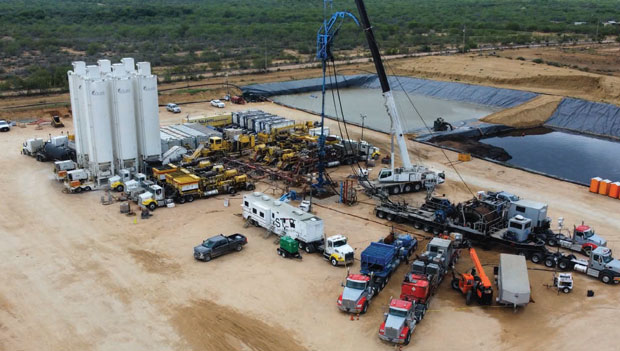
Operators Hone Strategies As Eagle Ford Shale Play Turns Sweet Sixteen
By Danny Boyd
It’s hard to believe, but the Eagle Ford Shale play is about to turn sweet 16. It may seem like only yesterday, but it was 2008 when the Eagle Ford discovery well in the Hawkville Field breathed first life into what would instantly become an activity epicenter of the first generation of U.S. shale exploration and development.
With the second—some may argue even third—era of shale development now underway, the Eagle Ford still has plenty of its original charms. The gigantic rock formation underlines a huge 26-county swath of acreage across the veritable geologic treasure chest of South Texas, and it is also connected to the overlying Austin Chalk both in terms of geology and petroleum system diagenesis. The large areal expanse and thick, complex subsurface environment give operators room to run both vertically and horizontally in more ways than simply wellbore orientation.
Of course, the Eagle Ford is also unique in that it offers distinctive oil, dry gas and wet gas/condensate windows defined by burial depths to grant operators the flexibility to selectively target liquids, gas or some combination thereof. To top it off, it is a relatively short hop from well sites to premium Gulf Coast petrochemical or export hubs, giving production an advantaged position with respect to basis differentials.
It took some pioneering innovators and big-time players to bring the Eagle Ford this far, but the future is about names such as Baytex Energy Corp., Tidal Petroleum, Castlerock Exploration, Ageron Energy LLC and BBL Operating. These are the companies leveraging technological muscle and outside-the-box strategic business partnerships to secure undrilled acreage along lease lines and find ways to enhance investment returns.
Recent consolidation among key players is helping iron sharpen iron in terms of advancing best practices and exploiting Tier 1 assets. Meanwhile, land trades are allowing companies to extend contiguous acreage blocks while production sharing agreements (PSAs) are enabling longer laterals as both large public companies and smaller private independents alike build drilling inventories and identify refracturing candidates.
Punching Above Its Weight
Baytex Energy is drilling across a broader portion of its Eagle Ford position after assuming ownership last summer of Ranger Oil and 269,000 liquids-rich gross acres, says Chief Operating Officer Chad Lundberg.
While Ranger focused on the central swath of volatile oil assets, Baytex is spreading the drilling focus through thermal maturity windows that include both black oil and condensate phases, he notes. Early results are strong: Each of nine wells brought on during the fourth quarter had average 30-day initial productivities of 1,600 barrels of oil equivalent a day, including 80% oil and NGLs.
The Calgary company’s Eagle Ford footprint now accounts for 60% of its production, or 92,000 boe/d, which are 60% oil and 80% liquids. Lundberg says 65% of cash flow is generated in South Texas from a purchase that included a trove of data and retention of an experienced Ranger staff overseeing U.S. operations from Houston, where Baytex has relocated its nonoperating oversight functions from Canada.
After assuming ownership last year of Ranger Oil and 269,000 liquids-rich gross acres, Baytex Energy is focusing on a 15-year drilling inventory with more than 800 net risked drilling locations in both the Upper and Lower Eagle Ford and Austin Chalk intervals.
“The Eagle Ford punches above its weight with respect to free cash flow and there is the opportunity to operate close to Gulf Coast markets,” Lundberg relates. “About one-third of U.S. refining capacity is there and our operations are within a couple hundred miles of it. There is a plethora of opportunity to get barrels to market.”
A 15-year drilling inventory includes more than 800 net risked drilling locations. The company’s efforts so far this year has been directed toward the Upper Eagle Ford, with drilling finished in April on a fourth well in the bench. However, the Lower Eagle Ford will be the primary target going forward with a limited number of Austin Chalk prospects, he details.
Deploying two drilling rigs and a frac crew, Baytex plans to turn some 50 operated wells to sales this year, in addition to about a dozen nonoperated wells. A 2024 goal of 8% improvement in operated drilling and completion costs per completed lateral foot is bearing fruit already, Lundberg reports. Rigs are drilling 1,700 feet a day, up from 1,400 feet last year, on average laterals of 9,800 feet. Frac fleet utilization has grown from 13.5 to 16.0 hours a day performing slickwater completions on wells with typical stage spacing of 250 feet with limited-entry perforating and 2,250 pounds of 100-mesh sand per foot.
The acquired Ranger assets came with 300 refrac candidates, about equal with the total number of refracs completed to date across the Eagle Ford, Lundberg notes. In February, the company completed its first restimulation using a 4.0-inch liner on a 4,880-foot lateral with 2,250 pounds of sand and 51 barrels of slickwater per foot. The $4.5 million project included a peak 30-day initial production rate of 671 boe/d, 78% oil.
For comparison, Lundberg says the original completion included 5.5-inch casing, a crosslink frac with 1,500 pounds and 30 barrels of fluid per foot, which yielded a 90-day IP of 788 boe/d. “The timing of refracs will be determined partially by scheduling to keep the frac crew busy and to ensure a measured approach that preserves capital and assesses any new data that changes restimulation planning,” he explains.
While always keeping an eye out for potential acquisition targets, Baytex has added bolt-ons and will execute production sharing agreements where it is beneficial to do so, he concludes.
Plentiful Opportunities
For original basin player Tidal Petroleum, production sharing agreements are helping the company grow its position and save money by splitting well costs with adjoining operators along lease lines to get longer laterals and superior returns, says President Lee Novikoff.
PSAs and additions of undrilled acreage sandwiched between larger operators are part of a business strategy of expanding drilling options on units with legacy wells that add to refrac inventory, he remarks.
Tidal Petroleum is among the Eagle Ford’s most experienced operators, drilling one of the first oil wells in the early days of the play. One of its key strategies today is to use production sharing agreements and additions of undrilled acreage sandwiched between larger operators to expand drilling options and refrac inventory on units with legacy wells.
Whatever the case for adding tracts and entering partnerships, Novikoff insists there is plenty of work left in South Texas. “Some may say the Eagle Ford as a major play is ending, and it may be difficult to grow production significantly, but there is enough opportunity here to maintain current production in the play for several years,” he evaluates.
Based in the San Antonio suburb of Schertz, Tx., Tidal opened for business in 1994 drilling shallow vertical wells but forged into the Eagle Ford on the South Texas Syndicate Ranch three months after neighbor Petrohawk drilled the play’s first successful well in the wet gas window. Tidal’s first well in northern LaSalle County was among the first few Eagle Ford oil wells, Novikoff recalls.
With an inventory of about 30 locations, the company this year is participating in nine wells across a 15,000-acre position that accounted for 88,000 barrels of oil in March. Novikoff says Tidal’s production is from smaller leases spread across Texas’ Atascosa, Fayette, Gonzales, Karnes, LaSalle, McMullen and Lavaca counties.
As larger companies weigh options to grow contiguous acreage, Tidal’s size allows it to acquire smaller, detached tracts by taking advantage of is ability to navigate the intricacies of securing title work on multiple leases required to cobble units together. Some townsites may include 75-80 different leases to make one, Novikoff says.
Although the Lower Eagle Ford is the primary target, Tidal has drilled wells in both the Lower and Upper intervals in a wine rack pattern with good results in Karnes and Gonzales counties, where the pay window is thick enough, he details.
Recent wells have included the Red Crest No. 3 and 4 in Gonzales County, with 5,700-foot and 6,400-foot laterals, respectively, that flowed a combined 2,000-2,200 barrels of oil and couple of million cubic feet of gas a day for several months. Nine months in, cumulative production is in excess of 300,000 barrels, Novikoff says.
Completion designs are similar to others in the region with stages around 200 feet stimulated with 2,500 pounds of 100-mesh sand per lateral foot. With more modern designs, recovery rates are three-four times higher than they were with the vintage frac designs pumped more than 10 years ago and pump rates have almost doubled, he observes.
Tidal has refrac candidates across its position. Five in LaSalle and Lavaca counties had strong results, Novikoff reveals. In Gonzales County, Tidal tested two refracs in thinner pays that were successful but with slower paybacks.
Big Part Of The Story
Among Castlerock Exploration’s 48 producing wells are refrac candidates being assessed as the operations team keeps an eye on results from other companies in the oil window in LaSalle and McMullen counties, says President and Chief Executive Officer Elliott Goudge.
“We think refracs could be a big part of the Eagle Ford story due to the vintage nature of the basin,” he observes.
Even as it assesses the potential for refracturing producing wells, Castlerock Exploration is growing its drilling inventory by adding proved, undeveloped reserves to an 8,000-acre, oil-weighted position. The company plans to drill eight new wells this year.
In the meantime, the Trace Capital-backed company is working to grow its drilling inventory by adding proved, undeveloped reserves to an 8,000-acre, oil-weighted position. Eight new wells are planned this year.
“We are growing and looking for more places to drill,” Goudge comments. “We are a small, nimble company, but our operations team speaks for itself.”
Drilling that began shortly after the latest iteration of the company launched in 2022 has yielded strong results with IPs north of 2,000 bbl/d on laterals exceeding13,000 feet in length.
“We have had success drilling longer laterals, which many companies are doing where they can and maximizing what we think is the right recipe for the area,” Goudge says. “Our results have been exciting to watch and dialing in the right completion and spacing is important to maximize value in the Eagle Ford.”
The work of Castlerock and others is extending the fringes of the oil window as more companies enter into PSAs to expand options, Goudge adds.
Much of what the team considers Tier 1 liquids-rich acreage in Karnes County, extending into LaSalle and McMullen, is being drilled, with growing interest in Tier 2 acreage in the region effectively becoming Tier 1 as operators shift priorities. The same can be said of Tier 3 acreage effectively transitioning to Tier 2, Goudge notes.
“The west side of the Eagle Ford was ripe for single-well leasehold early because large chunks of acreage could be held with one well, but that is becoming more developed, and you are seeing operators push the edges of the play,” he says. “We have seen extensions in the oil and gas windows of the play as inventory becomes more scarce.”
Innovating All The Time
In Webb County, Tx., on the western reaches of the trend, Ageron Energy LLC is utilizing wider spacing to get better results from Austin Chalk gas wells as it experiments with completion designs to lower costs and achieve more effective frac geometries, says CEO Bruce Gates.
Along with gas players across the country, the privately held San Antonio-based company is trimming daily production, to about 62 million cubic feet a day with output capacity close to double that, as it ratchets back drilling until the fourth quarter.
Still Gates is optimistic for the long term, given a position with 30 prospects in the deep gas Dorado play alongside EOG Resources and 11 others. Currently, Ageron operates 12 wells in Webb County and in April was doing its first 2024 completion.
Ageron Energy LLC is focused on natural gas targets in the Austin Chalk and Dorado plays. On one chalk well, Ageron is deploying cemented sleeves every 50 feet with one cluster per stage, which lessens downtime using coiled tubing to open/close sleeves and pumps only 40 barrels of fluid a minute during stimulation.
“It is a great asset and the production is phenomenal. We have some of the best acreage in the trend in the middle of the Dorado play,” he states. “These are fantastic wells with reserves of 15 billion-20 billion cubic feet equivalent.”
An overall 15,000-acre position includes oil production of 1,200 bbl/d on mature positions in Texas’ Zavala, Karnes, DeWitt and McMullen counties. In Webb County, Ageron has more than 30 undrilled locations with plans to continue utilizing wider well spacings of 1,500 feet, compared with about 1,000 feet for some neighboring operators.
Wider spacing has contributed to better production from the Austin Chalk, which is superior to the Eagle Ford bench with about a third less reserves, Gates says. However, designs include some wine rack patterns to tap into both benches, which are only 400 feet apart in places.
“Because we are doing 1,500 feet in the Austin Chalk, we will end up drilling 1,500 feet in the Eagle Ford, too, because we do not want communication directly above or below our wells,” he says.
In the chalk, the company prefers 8,000-foot laterals where lease configurations allow that can eventually produce 16 Bcfe-20 Bcfe, Gates details. Eagle Ford output can be more sensitive to lateral length with 10,000-foot wells able to ultimately produce 15 Bcfe, he adds.
The company typically uses 20-30 foot cluster spacings on 150-160 foot stages, pumping 3,000 pounds of sand a lateral foot. However, on an ongoing completion in April, Ageron experimented with a different design in hopes of trimming costs and getting more consistent frac heights and lengths, Gates explains.
On a 4,800-foot lateral length constrained by the lease configuration, the company is deploying cemented sleeves every 50 feet with basically one cluster per stage, which lessens downtime as coiled tubing opens and closes sleeves during stimulation. Only 40 barrels of fluid are pumped a minute. The design worked well on past Austin Chalk oil wells in the Pearsall in Field in Zavala County, Gates points out.
“I can see where we could get a competitive advantage using this, but right now, we are just trying it,” he says. “You have to be innovating all the time.”
Smooth Development Pace
In the Brazos Valley region northwest of Houston, private player BBL Operating Company continues to methodically develop a 10,000-acre position in southwestern Robertson County, Tx., chiefly targeting the Austin Chalk and Buda and after testing the Eagle Ford Shale with two wells near Hearne and will add two more this year six miles south closer to Bryan, says President Kipp Whitman.
BBL Operating is methodically developing its 10,000-acre position in southern Robertson County, Tx., with open-hole and cased-hole horizontal completions targeting primarily the Austin Chalk and Buda while also testing the underlying Eagle Ford Shale.
“We are a small company, we carry no debt, and we operate very simply, drilling two to three wells a year,” he explains. “All of our wells have been pretty good wells.”
Targeting the Austin Chalk has paid off with both open-hole and cased-hole completions on laterals extending to around 6,000 feet. After an open-hole completion with a minor frac seven years ago, the Long Tall Sally No. 1 produced more than 200 barrels of oil a day initially and was free flowing about 100 bbl/d for a year thereafter. Other recent Austin Chalk successes, all named after 1950s hits, include the Long Tall Sally No. 2, Long Tall Sally No. 3 and the Little Sister No. 1, Midnight Special 1 and 2, Johnny B Goode 1, Big Bad John, and so on.
A former actor, Whitman opted for an oil and gas career the 1980s with operations in Colorado, Nebraska, Kansas and California. Part of his inspiration came during his days playing parts on the television show Bonanza when fellow actor Dan Blocker, who played Hoss Cartwright, told him about a family oil field services business.
Whitman launched BBL in 2010 after exploring earlier in Pearsall and other South Texas counties, he says. In 2015, the company acquired the Robertson County position, along with acreage in neighboring Brazos County.
The company does some contract operating, but focusing mainly on its 15 producers allows BBL to continue to control the pace of its drilling, Whitman says.
“We are going to keep a nice, smooth, constant development pace, and we have enough acreage, while adding some new leases, to keep us busy for a good while,” he says.
For other great articles about exploration, drilling, completions and production, subscribe to The American Oil & Gas Reporter and bookmark www.aogr.com.











